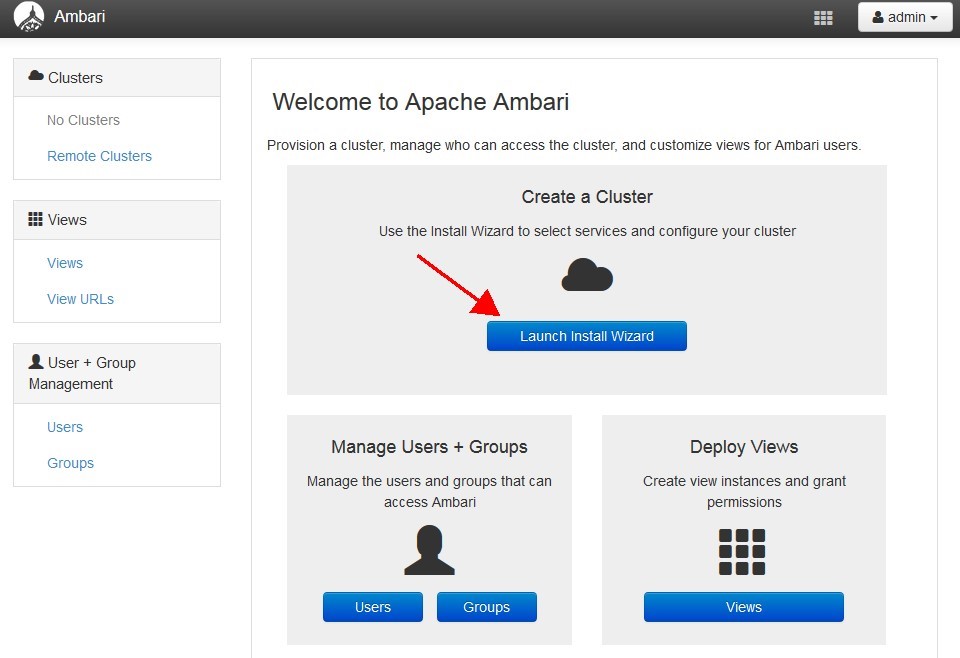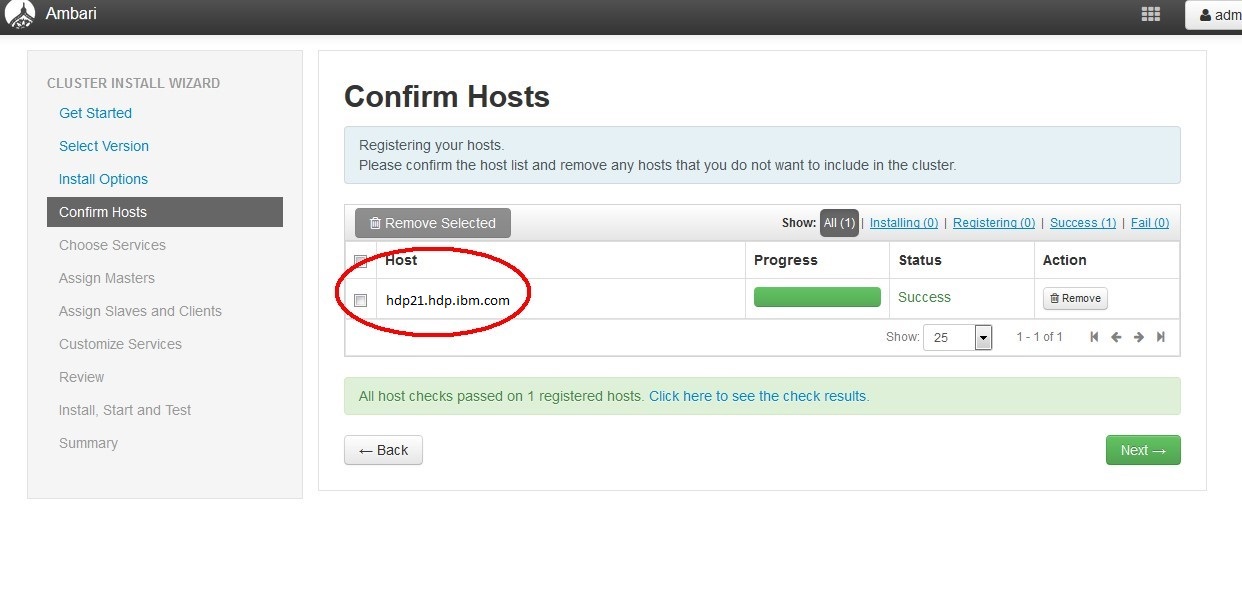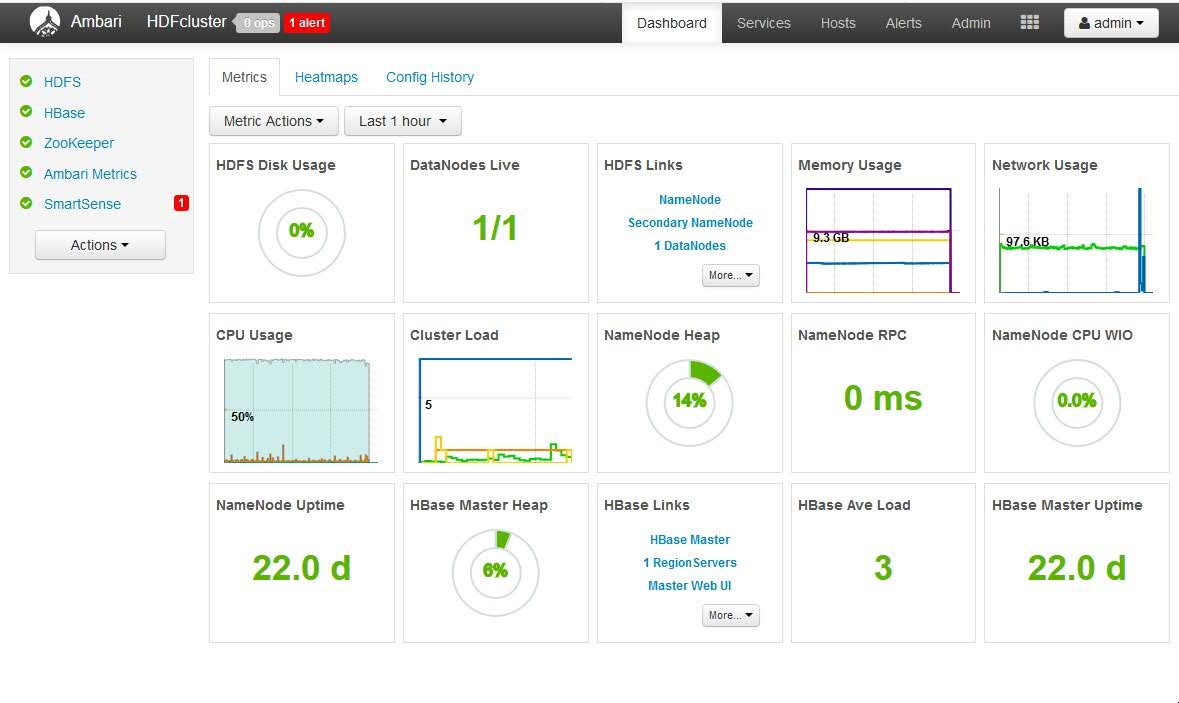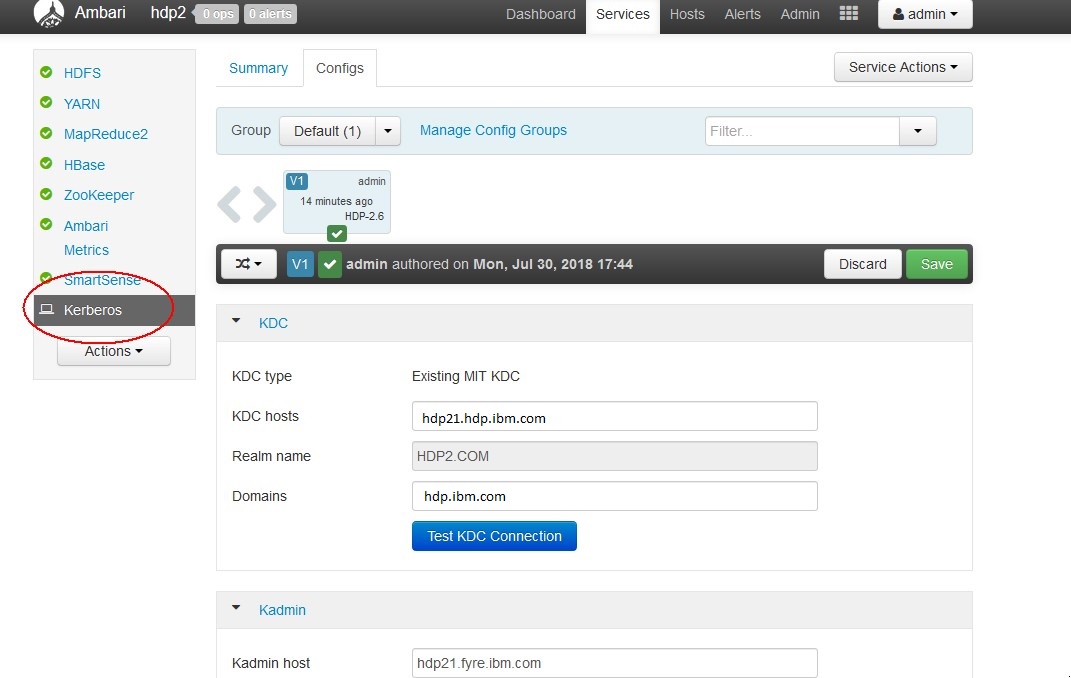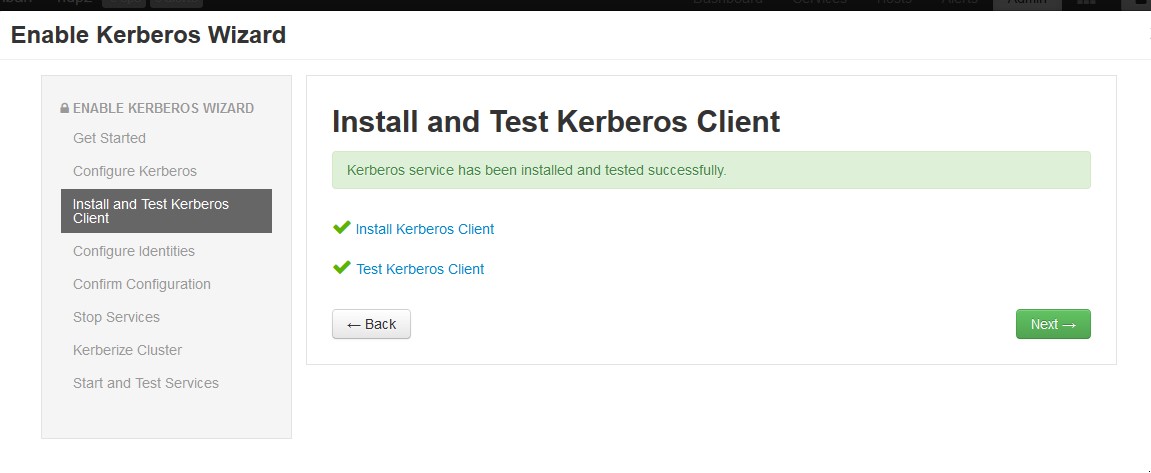-
Notifications
You must be signed in to change notification settings - Fork 20
How to use kerberos authentication in streamsx.hdfs toolkit
The streamsx.hdfs toolkit supports kerberos authentication.
This document describes a step by step procedure to:
-
Installation and configuration of Ambari
-
Installation of HDFS and HBASE start the services
-
Enabling kerberos
-
Using of principal and *keytab" in stremasx.hdfs toolkit.
A keytab is a file containing pairs of Kerberos principals and encrypted keys that are derived from the Kerberos password.
Here is a short installation and configuration guide for Ambari. For detail information about the installation of Ambari check this link: https://docs.hortonworks.com/HDPDocuments/Ambari-2.6.2.2/bk_ambari-installation/content/install-ambari-server.html
login as root:
cd /etc/yum.repos.d/
wget http://public-repo-1.hortonworks.com/ambari/centos7/2.x/updates/2.6.1.5/ambari.repo
for redhat 6
wget http://public-repo-1.hortonworks.com/ambari/centos6/2.x/updates/2.6.1.5/ambari.repo
Now install ambari-server and ambari-agent
yum install ambari-server
yum install ambari-agent
ambari-server setup -s -v
# accept all defaults and go to the next:
ambari-server start
ambari-server status
edit /etc/ambari-agent/conf/ambari-agent.ini file and adding the following configuration property to the security section:
[security]
force_https_protocol=PROTOCOL_TLSv1_2
Install and start ambari-agent in every hosts of your HBASE cluster.
ambari-agent start
ambari-agent status
If everything goes well you can see the following status:
Found ambari-agent PID: 1429
ambari-agent running.
Agent PID at: /run/ambari-agent/ambari-agent.pid
Agent out at: /var/log/ambari-agent/ambari-agent.out
Agent log at: /var/log/ambari-agent/ambari-agent.log
Now check the status of ambari-server
ambari-server status
Using python /usr/bin/python
Ambari-server status
Ambari Server running
Found Ambari Server PID: 16227 at: /var/run/ambari-server/ambari-server.pid
Start the ambari web configuration GUI. open this link in your browse.
http:/<your-hdp-server>:8080
default port is 8080 default user: admin default password: admin It is possible to change all these defaults. More details in:
https://ambari.apache.org/1.2.3/installing-hadoop-using-ambari/content/ambari-chap2-2a.html
Launch the Ambari Install Wizard and follow the installation and configuration. Registration of hosts.
Customizing of services: For HBASE and HBASE test it is recommended to install only the following services: HBASE, MapReduce2, HBase, ZooKepper.
Install and start the services:
It takes about 30 minutes (or more dependence to the number of your services) to install and start the services . Started Services
Now you can login as root on your HDP server and copy the configuration files to your client: Hadoop configuration file: /usr/hdp/current/haddop-client/conf/core-seite.xml
HBASE configuration file: /usr/hdp/current/hbase-client/conf/hbase-site.xml
Login as root in your hadoop server and install kerberos.
yum install krb5* -y
In the following example the realm name is HDP2 and the server is hdp21.hdp.ibm.com. You can change it with your realm name and your server name.
Edit Kerberos configuration file
vi /etc/krb5.conf
[libdefaults]
default_realm = HDP2.COM
dns_lookup_realm = false
dns_lookup_kdc = false
ticket_lifetime = 24h
forwardable = true
udp_preference_limit = 1000000
default_tkt_enctypes = des-cbc-md5 des-cbc-crc des3-cbc-sha1
default_tgs_enctypes = des-cbc-md5 des-cbc-crc des3-cbc-sha1
permitted_enctypes = des-cbc-md5 des-cbc-crc des3-cbc-sha1
[realms]
HDP2.COM = {
kdc = hdp21.hdp.ibm.com:88
admin_server = hdp21.hdp.ibm.com:749
default_domain = hdp.ibm.com
}
[domain_realm]
.hdp.ibm.com = HDP2.COM
hdp.ibm.com = HDP2.COM
[logging]
kdc = FILE:/var/log/krb5kdc.log
admin_server = FILE:/var/log/kadmin.log
default = FILE:/var/log/krb5lib.log
edit /var/kerberos/krb5kdc/kdc.conf
default_realm = HDP2.COM
[kdcdefaults]
v4_mode = nopreauth
kdc_ports = 0
[realms]
HDP2.COM = {
kdc_ports = 88
admin_keytab = /etc/kadm5.keytab
database_name = /var/kerberos/krb5kdc/principal
acl_file = /var/kerberos/krb5kdc/kadm5.acl
key_stash_file = /var/kerberos/krb5kdc/stash
max_life = 10h 0m 0s
max_renewable_life = 7d 0h 0m 0s
master_key_type = des3-hmac-sha1
supported_enctypes = arcfour-hmac:normal des3-hmac-sha1:normal des-cbc-crc:normal des:normal des:v4 des:norealm des:onlyrealm des:afs3
default_principal_flags = +preauth
}
Edit /var/kerberos/krb5kdc/kadm5.acl
3- Creating the KDC database
kdb5_util create -r HDP2.COM -s
4- Add a principal for root user
/usr/sbin/kadmin.local -q "addprinc root/admin"
5- Restart krb5kdc and kadmin services
/sbin/service krb5kdc stop
/sbin/service kadmin stop
/sbin/service krb5kdc start
/sbin/service kadmin start
Check the status of servers: if everything goes well you can see like this status:
/sbin/service krb5kdc status
Redirecting to /bin/systemctl status krb5kdc.service
krb5kdc.service - Kerberos 5 KDC
Loaded: loaded (/usr/lib/systemd/system/krb5kdc.service; disabled; vendor preset: disabled)
Active: active (running) since Mon 2018-07-30 08:13:40 PDT; 20h ago
Main PID: 2030 (krb5kdc)
CGroup: /system.slice/krb5kdc.service
└─2030 /usr/sbin/krb5kdc -P /var/run/krb5kdc.pid
Jul 30 08:13:40 hdp21.hdp.ibm.com systemd[1]: Starting Kerberos 5 KDC...
Jul 30 08:13:40 hdp21.hdp.ibm.com systemd[1]: Started Kerberos 5 KDC.
/sbin/service kadmin status
Redirecting to /bin/systemctl status kadmin.service
kadmin.service - Kerberos 5 Password-changing and Administration
Loaded: loaded (/usr/lib/systemd/system/kadmin.service; disabled; vendor preset: disabled)
Active: active (running) since Mon 2018-07-30 08:13:48 PDT; 20h ago
Main PID: 2045 (kadmind)
CGroup: /system.slice/kadmin.service
└─2045 /usr/sbin/kadmind -P /var/run/kadmind.pid
Now you can open your ambari GUI and enable Kerberos.
It restarts all service and create principals and keytab files for every user.
It is also possible to create your principals and keytab manually via kadmin tool.
kadmin -p root/[email protected]
Authenticating as principal root/[email protected] with password.
Password for root/[email protected]:
kadmin: listprincs
HTTP/[email protected]
K/[email protected]
activity_analyzer/[email protected]
activity_explorer/[email protected]
[email protected]
[email protected]
amshbase/[email protected]
amszk/[email protected]
dn/[email protected]
[email protected]
hbase/[email protected]
[email protected]
hbase/[email protected]
jhs/[email protected]
kadmin/[email protected]
kadmin/[email protected]
kadmin/[email protected]
kiprop/[email protected]
krbtgt/[email protected]
nfs/[email protected]
nm/[email protected]
nn/[email protected]
rm/[email protected]
root/[email protected]
yarn/[email protected]
zookeeper/[email protected]
It creates keytab files and saves them in /etc directory
/etc/security/keytabs
ls /etc/security/keytabs/
activity-analyzer.headless.keytab
activity-explorer.headless.keytab
ambari.server.keytab
ams.collector.keytab
ams-hbase.master.keytab
ams-hbase.regionserver.keytab
ams-zk.service.keytab
dn.service.keytab
hbase.headless.keytab
hbase.service.keytab
hbase.headless.keytab
jhs.service.keytab
nfs.service.keytab
nm.service.keytab
nn.service.keytab
rm.service.keytab
smokeuser.headless.keytab
spnego.service.keytab
yarn.service.keytab
zk.service.keytab
The csv file with list of principals configured can be download using following Ambari URL
https://<ambari_hostname:port>/api/v1/clusters/<Cluster_name>/kerberos_identities?fields=*&format=csv
Where the placeholders <ambari_hostname:port> , and <Cluster_name> has to be replaced with your server corresponding values.
If you have another hadoop server, you can enable Kerberos authentication on your Hadoop cluster.
The following links shows "how to enable the kerberos authentication in Hortenworks, Cloudera and IOP".
https://www.cloudera.com/documentation/enterprise/latest/topics/cm_sg_s4_kerb_wizard.html
Login as root in your hadoop server
useradd streamsadmin
su - hdfs
hadoop fs -mkdir /user/streamsadmin
hadoop fs -mkdir /user/streamsadmin/testDirectory
hadoop fs -chown -R streamsadmin:streamsadmin /user/streamsadmin
In the above sample the name of streamsuser is streamsadmin.
If your streamsuser has another username, you can create a HDFS user with your user name.
Kerberos authentication is a network protocol to provide strong authentication for client/server applications.
The streamsx.hdfs toolkit support kerberos authentication. All operators have 2 additional parameters for kerberos authentication:
The authKeytab parameter specifies the kerberos keytab file that is created for the principal. The authPrincipal parameter specifies the Kerberos principal, which is typically the principal that is created for the HDFS server.
-
1- Copy core-site.xml file from Hadoop server on your Streams server in etc directory of your SPL application.
-
2- Copy the keytab file from Hadoop server on your Streams server in etc directory of your SPL application.
-
3- Test the keytab For example:
kinit -k -t hdfs.headless.keytab <your-hdfs-pricipal>
If your configuration is correct, it creates a file in /tmp directory like this:
/tmp/crb5_xxxx
xxxx is your user id for example 1005
-
4- Add the hostname and the IP address of your HDFS server (cluster) in your /etc/hosts file on stream server.
-
5- If you have any problem to access to the realm, copy the crb5.conf file from your HDFS server into a directory and add the following vmArg parameter to all your HDFS2 operators in your SPL files: In this case the path of krb5.conf file is an absolute path For example:
vmArg : "-Djava.security.krb5.conf=/etc/krb5.conf";vmArgs is a set of arguments to be passed to the Java VM within which this operator will be run.
-
5- Create a test file in data directory and add some lines into the test file data/LineInput.txt
The following SPL application demonstrates how to connect to an HDFS via kerberos authentication.
It reads the lines from the file data/LineInput.txt via FileSource operator.
Then the HDFS2FileSink operator writes all incoming lines into a file in your HDFS server in your user directory.
For example:
/user/streamsadmin/HDFS-LineInput.txt
In the next step the HDFS2FileSource reads lines from the HDFS file /user/streamsadmin/HDFS-LineInput.txt.
In the last step the FileSink operator writes all incoming lines from HDFS file in your local system into data/result.txt
All project files are in :
https://github.com/IBMStreams/streamsx.hdfs/tree/gh-pages/samples/HdfsKerberos
namespace application ;
use com.ibm.streamsx.hdfs::HDFS2FileSink ;
use com.ibm.streamsx.hdfs::HDFS2FileSource ;
composite HdfsKerberos
{
param
expression<rstring> $authKeytab : getSubmissionTimeValue("authKeytab", "etc/hdfs.headless.keytab") ;
expression<rstring> $authPrincipal : getSubmissionTimeValue("authPrincipal", "[email protected]") ;
expression<rstring> $configPath : getSubmissionTimeValue("configPath", "etc") ;
graph
stream<rstring lines> LineIn = FileSource()
{
param
file : "LineInput.txt" ;
}
() as lineSink1 = HDFS2FileSink(LineIn)
{
param
authKeytab : $authKeytab ;
authPrincipal : $authPrincipal ;
configPath : $configPath ;
file : "HDFS-LineInput.txt" ;
}
stream<rstring lines> LineStream = HDFS2FileSource()
{
param
authKeytab : $authKeytab;
authPrincipal : $authPrincipal ;
configPath : $configPath ;
file : "HDFS-LineInput.txt" ;
initDelay : 10.0l ;
}
() as MySink = FileSink(LineStream)
{
param
file : "result.txt" ;
flush : 1u ;
}
}
